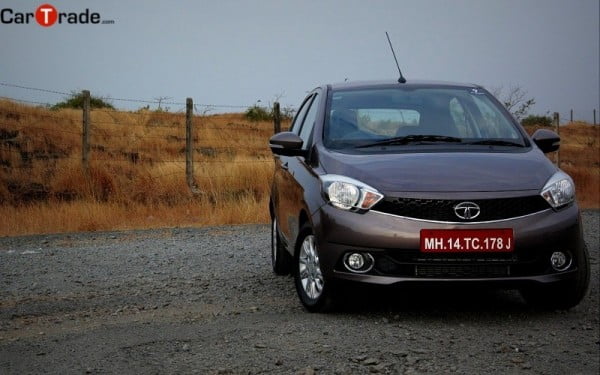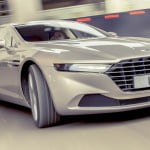The hatchback segment in India is a hotly contested one. Competition is high and every new entry has to face well-established entries from the country’s top-two car manufacturers. That said, hatchback sales are all about numbers. This is where the volumes are and Tata Motors has made their intentions clear that they want a share of this pie. Leading the assault is the ZICA. Short for ‘Zippy Car’, the ZICA is Tata’s best ever effort in the hatchback space. Launched in both, Diesel & Petrol variants, we spent some time with them to bring you our initial impressions.

Designers across Tata’s design studios in Pune, UK and Italy have worked on the car’s design and it shows. The styling on the ZICA is expressive and exciting, with the new design language being a strong indicator for products in the future. Coming back to the car, it sports a sculpted look, with sharp creases and bold lines everywhere. Up front is the signature, hexagonal grill that is placed vertically. The TATA logo sitting in the middle is new, as well, sporting a bolder, more prominent look. The smoked-lens headlamps sport a black bezel. It contrasts nicely with the chrome surrounds on the fog-lamps. The trendy looking spats on the spoiler at the back add to the sportiness of the car and also improve aerodynamics. The overall stance of the car indicates agility, with the sharp nose adding a very shark-like feel to it. The car looks very youthful and trendy, turning heads during our short time on the road.
The Zica’s interiors are a marked improvement over what we’ve seen on earlier products from the manufacturer. The cabin is finished in black and grey. Tata’s decision to avoid using beige on the inside is a welcome one. The ZICA’s interiors have a very premium feel to them. Tata have used a lot of textures, both in the fabrics used as well as the plastic trims. This is evident in the geometric design of the headliner and the seats, to the door pads and the dashboard. On the top variants, the air-conditioning vent surrounds are finished in the exterior shade, bringing a nice splash of colour to the interior. The driver’s seat gets manual height adjust and the seats overall offer good bolstering. The cushioning on offer could be a bit soft for extended driving times, though we’ll wait for a proper test drive before commenting on this.

All the controls are within easy reach, and the indicator/headlight stalks have a premium, damped feel to them. The instrument cluster is finished smartly, featuring both, a rev-counter as well as the speedometer. There is a tell-tale, multi-information display that’s integrated into the centre of the instrumentation counter. This gives a detailed reading on the distance travelled, the overall fuel efficiency, real-time fuel consumption figures and the trip meter. There is also a useful gear indicator that serves to optimize gear-shifts.
The Zica gets the next generation, ConnectNext Infotainment system from Harman. The unit is well integrated into the dashboard and gets classy piano-black surrounds as well. The sound quality is quite good at low and medium listening levels. The speakers are punchy and have good bass, though they get overwhelmed at very high volumes. The HVAC unit on the ZICA is a chiller, particularly on the Diesel version. The flow of air too is good, and it shows that Tata have put some thought behind it, with even the passengers in the rear seat were kept cool and happy. The rotary control knobs have a tactile feel to them, though they could be finished better.

Interior space is a strength of the Zica with enough leg-room for both, the driver and the co-driver at the front and the two passengers in the rear seat. Things do get a bit cramped at the back, in-case a third passenger decides to join in at the rear. Tata have also addressed the concerns on storage space within the cabin that had cropped up on the Bolt & the Zest. The Zica, gets a total of 22-storage spaces. From a dual-zone glove box (which is chilled, by the way) to the tiny coin-slot on the driver’s side, Tata have given things a fair bit of thought. The 240-litre boot may be a bit low when compared to the competition, but suspension intrusion is kept to a minimum, ensuring high usability. The Zica also gets multiple hooks within the cabin and in the boot, to hang bags, coats and their ilk. Each hook gets a weight rating to take the guess-work out of the load-bearing capacity – a smart move from Tata.
The Zica gets dual-airbags at the front and ABS with EBD and corner stability control. In addition to this, the Zica’s body shell has also been carefully designed to absorb the maximum load during crashes, ensuring higher passenger safety.
The 1.05 litre diesel engine in the Zica develops about 69 bhp of power. It also sports the highest torque figures of 140 Nm between 1800-3000 rpm in the segment. The three-cylinder diesel motor is the first of the new-generation motors from the Revotorq family. It gets dual overhead camshafts and central injectors. Tata have worked upon the technical details, optimizing the valve lift and giving it a low-friction crank to ensure optimum fuel efficiency. They have also worked hard on the cost-of-ownership factor, by improving the reliability and the life-cycle of key engine components like the timing belt, the auxiliary belt and the filters used.
The 1.2 litre petrol motor develops about 84 bhp and 115 Nm of peak torque at 3500 rpm. It comes with Variable Cam Timing (VCT-i) and a variable oil-pump to improve efficiency. Tata have given this engine a durable chain-drive system, hydraulic lash adjusters and an auto-tensioner to drive down cost of ownership.
Both engines have been tuned for drivability and maximum fuel-efficiency. To aid-this, they get Tata’s signature multi-drive mode – City and Eco. The former is the default mode on, while the Eco mode is switchable. The diesel feels a lot peppier, being eager to drive. Turbo-lag is minimal and there is little hesitation between gears. Thanks to the best-in-class torque and the well-chosen gear ratios, the car tracks stable and true even on the highway. Overtaking is a breeze and one can cruise comfortably at ton-up speeds. The petrol engine is better suited to pottering about in the city. With highway driving requiring the engine to be kept on the boil. Overtaking manoeuvres are best planned in advance and aided hugely by dropping a gear. Drivability is good, though one can feel the torque difference after driving the diesel engine. NVH levels are low on both cars, though road noise did creep in in the petrol. Another thing noticed is the vibrations that creep up through the gear-lever on the petrol. They aren’t as pronounced as they were in the Zest, but they’re present nevertheless.
[“source-cartrade”]





